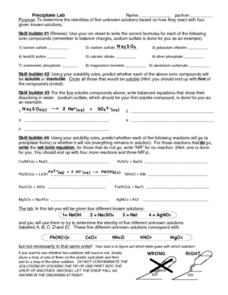Curated OER
Chapter 13 Review, Section 1: Ions in Aqueous Solutions and Colligative Properties
This is an apt assignment for chemistry takers that are studying ionic solutions. Eight questions require problem solving and critical thinking to answer. The first question instructs learners to use a table in the textbook, but you can...
Curated OER
Transition Metal Ions and Colour
In this transition metal instructional activity, students are given equations of transition metals and their ions. Each equation shows the changes in colors of the ions when heat, salt or other substances are added to the metals.
Curated OER
Qualitative Analysis
In this qualitative analysis worksheet, students read about all the different tests that can be done in chemistry to give qualitative results. Tests include flame tests, forming precipitates with sodium hydroxide, using sodium hydroxide...
Curated OER
What is a Chemical Reaction?-Evidence of Change
For this chemical reactions worksheet, students experiment with hydrochloric acid and copper (I) chloride to identify the types of reactions they undergo with various other substances. They also observe the law of conservation of mass...
Curated OER
WS 10.1 Solubility Product
In this solubility worksheet, students find the solubility product constants for four compounds and use solubility product constants to determine solubility data of four compounds.
Curated OER
WS 10.2 Electrolytes and Solubility
In this electrolytes and solubility learning exercise, students answer questions about electrolytes and write balanced equations for the dissociation of salts in water. They also determine solutes that are soluble in water and write...
Curated OER
Precipitate Lab
This lab guide gets chemistry students to determine the identity of five unknown solutions based on reactions with four known solutions. Pupils perform experiments, they write down their observations, they write net ionic equations for...
Curated OER
Solubility Equilibria
In this solubility equilibria instructional activity, students solve five problems. They calculate concentrations of ions at equilibrium, they determine the effects of adding compounds to a saturated solution and they determine if...
Curated OER
Chemistry: Chemical Reaction
In this chemical reactions worksheet, students name the reactants and products, balance the equation, calculate the molecular weight of the reactants and products, and classify each reaction type. Students fill in a table of solubility...
Curated OER
Chemical Equations
In this chemical equations worksheet, students review chemical changes, define catalysts and coefficients, and review the five general types of reactions. This worksheet has 12 fill in the blank and 42 short answer questions.
Curated OER
Follow Up Questions Lab 1-Chemical Reactions
In this chemical reactions worksheet, students answer follow up questions to a lab where they were observing chemical changes in reactions after mixing products such as hydrochloric acid and sodium bicarbonate. They answer six questions...
Curated OER
Hard Water
In this water activity, students read how hard water is created and what can be done to soften the water. Then students complete 6 short answer questions.
Curated OER
Qualitative Analysis and Ksp Calculations
In this compounds worksheet, students determine which anion is present in solution from the results of testing with various reagents. Students compare the solubility of different compounds in water. This worksheet has 7 fill in the blank...
Curated OER
Displacement Reactions and Acid/Base Reactions
In this chemical reactions worksheet, students review the solubility rules for common salts. Students determine the molecular equation, ionic equation, and net ionic equation for specific reactions. Students calculate moles and volume...
Curated OER
Limiting Reactant
In this chemistry worksheets, students calculate the amount of reactants and products are produced by the given equations. Students also calculate the number of moles as well as the mass of the given compounds.
Curated OER
DNA Extraction
In this DNA extraction worksheet, high schoolers learn how to extract DNA from various foods. Students complete 2 short answer questions.
Curated OER
Solubility Homework Problem Set
In this chemistry worksheet, students write the balanced equation for the reaction and rearrange the potassium expression to solve for x. Then they determine how many grams of silver chromatic can dissolve in a specified amount of sodium...
Curated OER
Water Testing
In this water testing pre-lab activity, students describe positive ions, precipitate, and the Tyndall effect. This activity has 14 short answer questions.
Curated OER
Science: What Happens to Create the Lode?
High schoolers understand how mineral deposits are formed and why they are not evenly dispersed. They create and describe three different precipitates from four solutions simulating mineral ore deposit formation in sedimentary rock.
Curated OER
Micro-Magic With Sticky Ions
High schoolers view a video about the formation of precipitates. They complete a worksheet that asks them to identify what makes a compound form and what holds it together.
Curated OER
AdVENTurous Findings on the Deep Sea Floor
Students conduct investigations to observe formations of precipitates, then create models of developing hydrothermal vents. They compare the models with the actual hydrothermal vents developing along the Galapagos Rift.






















